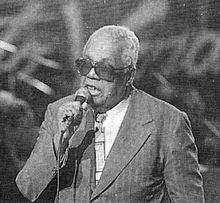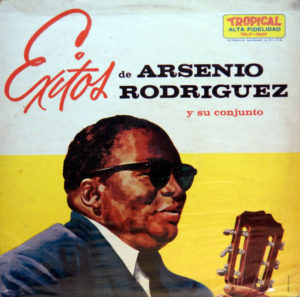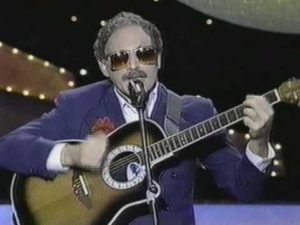 INTERPRETES CIEGOS DESTACADOS EN LA HISTORIA DE LA MUSICA CUBANA.
INTERPRETES CIEGOS DESTACADOS EN LA HISTORIA DE LA MUSICA CUBANA.
La historia de la musica cubana nos ha dado a conocer desde la década del 50 la vida de varios músicos ciegos, lo cual no era un obstáculo para conseguir un lugar de honor entre los interpretes de la mejor música en nuestra nación. Ellos han llegado a compartir la misma discapacidad con la misma pasión de verdaderos creadores, mencionando algunos de los mas conocidos:
Este popular cantante convirtió en un disco de oro las más variadas composiciones de esta forma. En la década de los 60, en la sala de música de la Biblioteca Nacional, el artista más popular de los estudiantes que acudieron a este lugar fue José Tejedor, junto con el increíble dúo realizado con Luis Oviedo.
Durante más de 20 años mantuvo su programa ‘Tejedor en la tarde’, en la emisora de radio COCO, lugar en el que hizo popular algunos de sus grandes éxitos como ‘En las tinieblas’, ‘Dos veces’, ‘Cuando estés muy sola’ Como nave sin rumbo ‘,’ Con tu nombre en los labios ‘. Y entre sus discos se encuentran: Escándalo, Pasión sin freno, Llora corazón, Mi Magdalena.
https://youtu.be/qSquvkQ25YU
En 1959, como cantante profesional, realizó su primera grabación con la pequeña disquera Rosy y contó con la participación del pianista y arreglista Javier Vázquez. Más tarde, Tejedor sería contratado por la productora Discuba.
Tejedor murió el 2 de noviembre de 1991 en La Habana.
Arsenio Rodríguez nació el 31 de agosto de 1911 en Güira de Macurijes, municipio de Pedro Betancourt, en la provincia de Matanzas y en una fragua de allí; Se dice que perdió la vista debido a una retina de pigmento no diagnosticada.
La verdad es que este neto esclavo del Congo tomó de la sabiduría de sus orígenes africanos ancestrales junto con la herencia española para hacer un ajiaco musical que hizo una revolución en la música bailable cubana, por lo que fue reconocido por la posteridad como El ciego maravilloso, El Ciego Maravilloso ”
El propio músico explicó las contribuciones que hizo al hijo, agregando el viejo formato de septeto (trompeta, guitarra, tres) un piano, tres trompetas y un tambor. Esto, según los expertos, no fue sólo una expansión del formato instrumental, sino que también ofreció una gran variedad de ritmos y conceptos armónicos que enriquecerían al bolero, la guaracha y el mambo, siendo uno de los Precursores de este último ritmo.
En la década de los 50 fue a Los Estados Unidos y en Nueva York es considerado uno de los padres de la Salsa.
Además de ser un excelente tresero, el llamado “El Ciego Maravilloso” dejó múltiples canciones como compositor, entre las que podemos mencionar: ‘Bruca maniguá’, ‘Dame un cachito pa’huelé’, ‘El reloj de Pastora’, ‘Fuego en el 23’, ‘La yuca de Catalina’, ‘No me llores’, ‘Yo soy Kangá’, ‘La vida es un sueño’, ‘La ruididera’, ‘Llora timbero’, ‘Meta y guaguancó’, ‘Como traigo la yuca’, ‘Confórmate’, ‘Corazón de chivo’, ‘El Cerro tiene la llave’ y otros.
Arsenio murió en Nueva York en 1970 y está enterrado en el cementerio de Ferncliff, donde una placa del Bronx con letras de oro toma su nombre, fecha de nacimiento y muerte, mientras una pequeña bandera cubana deja evidencia de la tierra en la que nació.
Osvaldo Rodriguez nació en los Arabos, provincia de Matanzas y su ceguera no fue un obstáculo para que su nombre pudiera escribirse con sus propias letras en la música. Obtuvo tres Golden Records, el premio más alto que ofrece la Grabación y Ediciones Musicales Enterprise (EGREM, por sus siglas en español).
Tuvo dos grandes éxitos: el primero como director y fundador de la banda ‘Los 5-U-4’, donde sólo uno de sus miembros no era ciego, y el otro como compositor con canciones como ‘Calle San Nicolás’ ‘De lo simple a lo profundo’, ‘En casa del pobre’ y el tan popular ‘Se me perdió el bastón’ y el bolero de todos los tiempos que se llama ‘El amor se acaba’.
Otros galardones fueron el Silver Record por ser el cantante más popular en 1978, el Sochi Youth Song Festival, el Gran Premio, la ex Unión Soviética y el XII Festival Mundial de la Canción Popular, Gran Premio celebrado en Tokio, Japón.
Rodríguez, además de ser un cantante con una gran voz, es un arreglista y guitarrista. Todas las canciones que interpreta están compuestas por él. Tiene una gran cantidad de composiciones inéditas que aún no se han grabado, y debido a las características únicas de su país natal, Cuba, muchos de sus éxitos nunca han sido explotados comercialmente, y algunos de ellos ni siquiera han sido grabados. Osvaldo vive en Estados Unidos hoy.
El destacado pianista cubano Frank Emilio, según sus propias confesiones, nunca vió imágenes, solo luces y colores con el ojo izquierdo hasta los 13 años cuando se volvió completamente ciego. Él solía tocar el piano sólo por escuchar y ser un niño, él estaba en diferentes bandas de música popular.
Con Armando Romeu, preparó un libro de estudio paralelo de notación musical en el sistema Braille y el común que permitió a profesores y transcriptores con visión trabajar para ciegos y con problemas de visión.
Su grabación es amplia y solo mencionamos algunos: ‘Frank Emilio interpreta a Ignacio Cervantes,’ Magada Intl ‘,’ 2000 ‘,’ Ancestral Reflections ‘,’ Blue Note ‘,’ 1999 ‘,’ Cuban Revolution Jazz ‘ Artistas) Milán, 1999, ‘Tributo a Lecuona’, Milán, 1997, Los maestros del piano cubano, con Jane Bunnett y otros, EMI. In LP records: ‘Rico Melao’, Egrem, Jazz 6PM. Egrem, Pianoforte Egrem, Tropicana, Volúmenes 1, 2,3 (Modern Music Quintet) Egrem, ‘Danzas Cubanas’ Egrem, Paisajes de España Duarte, ‘La Flauta en el Danzón’ Egrem, Frank Emilio presents a Frank Emilio, Egrem.
Durante la década de 1990, Flynn grabó varios álbumes, entre ellos Barbarísimo (1996), Tributo a Ernesto Lecuona (1997) y A Tiempo de Danzón (1998) para Milan / RCA Records, y Ancestral Reflections (1999) para Blue Note. En diciembre de 1997, Flynn participó en el Jazz Plaza Festival en La Habana. En febrero de 1998 hizo su debut estadounidense, con Los Amigos, en un concierto de Jazz at Lincoln Center. Al año siguiente se reunió con sus parientes estadounidenses.
Entre 2000 y 2001, pasó gran parte de su tiempo con sus familiares en California, donde ocasionalmente tocaba en vivo y daba conferencias en la Universidad Estatal de California, Los Ángeles. Frank Emilio murió el 23 de agosto de 2001 en La Habana. Fue enterrado en el cementerio Colón.
 BLIND INTERPRETERS DISTINGUISHED IN CUBAN MUSIC HISTORY.
BLIND INTERPRETERS DISTINGUISHED IN CUBAN MUSIC HISTORY.
The history of Cuban music has made known to us since the ’50s the life of several blind musicians, which was not an obstacle to obtaining a place of honor among the interpreters of the best music in our nation. They have come to share the same disability with the same passion of true creators, mentioning some of the best known:
This popular singer turned the most varied compositions of this form into a gold record. In the 60s, in the music room of the National Library, the most popular artist of the students who attended this place was José Tejedor, along with the incredible duo made with Luis Oviedo.
For more than 20 years he kept his program ‘Weaver in the afternoon’, on the COCO radio station, place where he made some of his greatest hits popular as’ In the darkness’, ‘Twice’, ‘When you are very lonely ‘Like ship aimlessly’, ‘With your name on the lips’. And among his albums are ‘Scandal’, ‘Passion without brake’, ‘Cry heart’, ‘My Magdalene’.
In 1959, as a professional singer, he made his first recording with the small label Rosy and had the participation of pianist and arranger Javier Vázquez. Later, Weaver would be hired by the production company Discuba.
Weaver died on November 2, 1991, in Havana.
Arsenio Rodríguez was born on August 31, 1911, in Güira de Macurijes, municipality of Pedro Betancourt, in the province of Matanzas and in a forge there; It is said that he lost his sight due to an undiagnosed pigment retina.
The truth is that this net slave of the Congo took the wisdom of his ancestral African origins along with the Spanish heritage to make a musical ajiaco that made a revolution in Cuban dance music, so he was recognized by posterity as The Wonderful Blind, The Wonderful Blind ”
The musician himself explained the contributions he made to the son, adding the old septet format (trumpet, guitar, three) a piano, three trumpets, and a drum. This, according to experts, was not only an expansion of the instrumental format, but also offered a great variety of rhythms and harmonic concepts that would enrich the bolero, the guaracha, and the mambo, being one of the Precursors of the latter rhythm.
In the 50s he went to the United States and in New York is considered one of the parents of Salsa.
In addition to being an excellent tresero, the so-called “The Blind Wonderful” left multiple songs as a composer, among which we can mention: ‘Bruca maniguá’, ‘Give me a little piece of pa’huelé’, ‘The clock of Pastora’, ‘Fire in the 23 ‘,’ Catalina’s yucca ‘,’ Don’t cry to me ‘,’ I am Kangá ‘,’ Life is a dream ‘,’ La ruididera ‘,’ Llora timbero ‘,’Meta y guaguancó’,’How I bring la yuca’,’Confórmate’,’ Corazon de goat’,’El Cerro has the key’ and others.
Arsenio died in New York in 1970 and is buried in the Ferncliff cemetery, where a Bronx plaque with gold letters takes his name, date of birth and death, while a small Cuban flag leaves evidence of the land in which he was born.
Osvaldo Rodriguez was born in Los Arabos, province of Matanzas and his blindness was not an obstacle for his name to be written in his own lyrics in music. He won three Golden Records, the highest award offered by Recording and Musical Editions Enterprise (EGREM).
He had two great successes: the first as director and founder of the band ‘Los 5-U-4’, where only one of its members was not blind, and the other as a composer with songs like ‘Calle San Nicolás’. deep down ‘,’ In the house of the poor ‘and the popular’ I lost my cane ‘and the bolero of all time called’ Love ends’.
Other awards were the Silver Record for being the most popular singer in 1978, the Sochi Youth Song Festival, the Grand Prix, the former Soviet Union and the 12th World Festival of the Popular Song, Grand Prix held in Tokyo, Japan.
Rodriguez, besides being a singer with a great voice, is an arranger and guitarist. All the songs he plays are composed by him. It has a large number of unpublished compositions that have not yet been recorded, and due to the unique characteristics of its native country, Cuba, many of its successes have never been commercially exploited, and some of them have not even been recorded. Osvaldo lives in the United States today.
The prominent Cuban pianist Frank Emilio Flynn, according to his own confessions, never saw images, only lights, and colors with his left eye until age 13 when he became completely blind. He used to play the piano just by listening and being a child, he was indifferent bands of popular music.
With Armando Romeu, he prepared a parallel study book of musical notation in the Braille system and the common one that allowed teachers and transcriptionists with the vision to work for the blind and with vision problems.
His recording is wide and we only mention a few: ‘Frank Emilio plays Ignacio Cervantes,’ Magada Intl ‘,’ 2000 ‘,’ Ancestral Reflections’, ‘Blue Note’, ‘1999’, ‘Cuban Revolution Jazz’ Artists) Milan, 1999, ‘Tribute to Lecuona’, Milan, 1997, The masters of the Cuban piano, with Jane Bunnett and others, EMI. In LP records: ‘Rico Melao’, Egrem, Jazz 6PM. Egrem, Pianoforte Egrem, Tropicana, Volumes 1, 2,3 (Modern Music Quintet) Egrem, ‘Cuban Dances’ Egrem, Landscapes of Spain Duarte, ‘The Flute in the Danzon’ Egrem, Frank Emilio presents Frank Emilio, Egrem.
During the 1990s, Flynn recorded several albums, including Barbarísimo (1996), Tribute to Ernesto Lecuona (1997) and A Tiempo de Danzón (1998) for Milan / RCA Records, and Ancestral Reflections (1999) for Blue Note. In December 1997, Flynn participated in the Jazz Plaza Festival in Havana. In February 1998 he made his American debut, with Los Amigos, at a Jazz at Lincoln Center concert. The following year he met with his American relatives.
Between 2000 and 2001, he spent much of his time with his relatives in California, where he occasionally played live and gave lectures at California State University, Los Angeles. Frank Emilio died on August 23, 2001, in Havana. He was buried in the Columbus cemetery.
Agencies/ Wiki/ CubanMusicArch/ Pedro J. Herrera/ Internet Photos/ YouTube/ Arnoldo Varona/ www.TheCubanHistory.com
THE CUBAN HISTORY, HOLLYWOOD.









